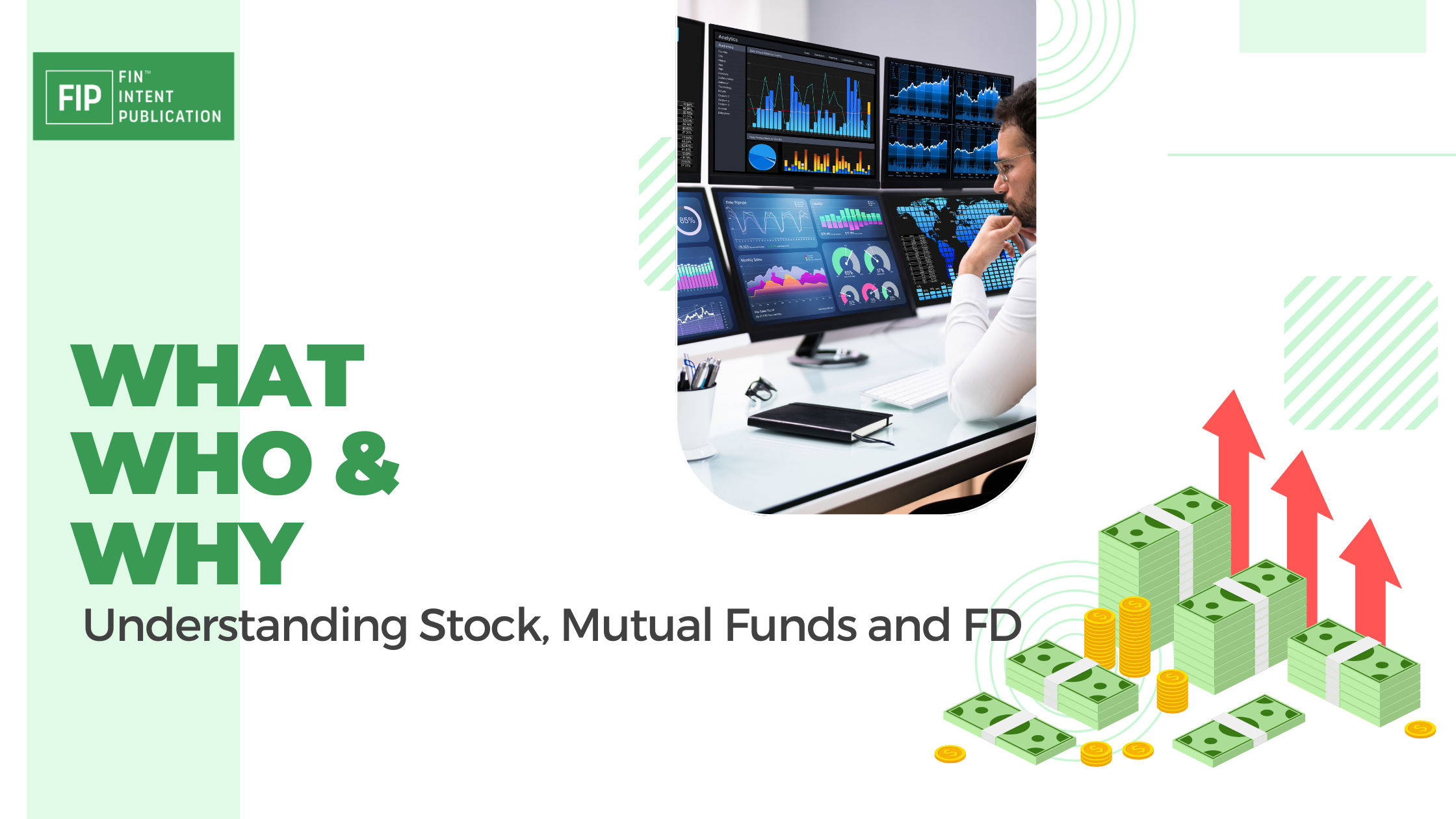Introduction
Stocks, mutual funds, and Fixed Deposits (FDs) represent staple investment choices, each catering to different investment goals and timeframes for return on investment (ROI). Stocks tend to attract individuals seeking substantial returns in a shorter period. They’re favoured by those aiming for quick gains or short-term investments. On the other hand, Fixed Deposits (FDs) are preferred by individuals looking for a long-term investment horizon, often exceeding 20 years. They’re considered a stable option for those seeking consistent, albeit slower, growth in their investment.
Mutual funds often strike a balance. Investors eyeing a medium-term goal, like purchasing a car or a house, find mutual funds appealing. They’re seen as a safer alternative to stocks while offering more profit potential compared to FDs.
Understanding these distinctions can help investors align their choices with their specific financial goals and timelines.
Fundamentals of Investing
Investing involves deploying your money now to secure a future source of income and wealth growth. Its essence lies in both creating and safeguarding your financial resources. Through a calculated level of risk, you open avenues for potentially higher returns over the long haul. However, it’s crucial to note that investments carry the risk of fluctuating values—both gains and losses are possible, and investors might receive less than their initial investment.
For most people, investing aims to yield profits or positive returns within a reasonable timeframe. The bedrock of a successful investment plan rests on comprehending your short, medium and long-term financial goals. Your chosen investment strategy aligns with these objectives.
Investment opportunities span various avenues, including stocks, bonds, mutual funds, real estate, gold, and more. Regardless of the avenue chosen, the fundamental goal remains constant: put your money to work, allowing it to generate additional profits. Though this concept might seem simple, it underpins the crux of successful investing and warrants your understanding.
What is stock investing?
Stocks represent a form of security that grants shareholders a portion of ownership in a company.
Businesses often issue shares primarily to raise funds for expanding their operations. This process, known as the initial public offering (IPO), marks the company’s debut in the stock market. Subsequently, shareholders have the option to trade these shares within the stock market. Stock market investing is where you can make short-term investments to get a substantial return with calculated risk.
Types of Stock
Common Stock:
– A basic type of stock granting voting rights and often dividends to shareholders.
Preferred Stock:
– Typically lacks voting rights but offers dividend distributions, sometimes with priority in payouts.
– May resemble bonds with fixed maturity dates and lower appreciation potential compared to common stock.
Large-Cap Stock:
– Shares from large companies with market capitalization typically over $10 billion.
– Examples: Microsoft (MSFT), Apple (AAPL), ExxonMobil (XOM), Walmart (WMT), Coca-Cola (KO).
Mid-Cap Stock:
– Shares from mid-sized companies, with market capitalization between $2 billion and $10 billion.
– Examples: Under Armour (UAA), Foot Locker (FL), Fair Isaac Corporation (FICO), Chewy (CHWY), and DocuSign (DOCU).
Small-Cap Stock:
– Shares from smaller companies, usually under $2 billion in market capitalization.
– Numerous small-cap stocks in the market due to most companies staying below the $2 billion threshold.
Growth Stock:
– Anticipated to have high returns due to companies being on a growth trajectory.
– Can be riskier, potentially overvalued by the market, often seen in tech stocks.
Value Stock:
– Typically undervalued by the market, offering potential value for investors.
– Preferred by investors like Warren Buffett, less exciting but potentially profitable.
International Stock:
– Shares from non-U.S.-based companies, used for diversification or exposure to foreign economies.
Blue-Chip Stock:
– Shares of renowned, stable companies with established growth and profitability.
Income Stock:
– Provides regular income streams, often through high dividend distributions.
– Examples include utility, telecom, real estate, and waste management companies.
Who should invest in stock?
Investing in stocks suits individuals seeking long-term investment and are comfortable with market fluctuations. It’s ideal for those with a tolerance for risk and a horizon of at least five years. Investors willing to conduct research, diversify their portfolios, and weather market volatility can benefit. However, it’s not for those needing immediate cash or a guaranteed return. Understanding personal financial goals and having a willingness to learn about the market are crucial. Stocks are suitable for those aiming for substantial wealth accumulation over time and are willing to navigate the uncertainties inherent in the stock market.
What are mutual funds?
A mutual fund is an investment pool combining assets from multiple shareholders to invest in various securities such as stocks, bonds, and money market instruments. Skilled fund managers handle these investments, aiming to generate profits or income for investors. The fund’s portfolio aligns with the objectives outlined in its prospectus.
These funds offer individual investors access to professionally managed portfolios of diverse securities. Each investor shares in the fund’s gains or losses proportionate to their holdings. Mutual funds spread their investments across numerous securities, often tracking performance through changes in the fund’s total market cap, reflecting the overall performance of its underlying investments.
Types of mutual funds
Stock Funds:
– Invest in equities, categorized by company size or investment approach.
– Includes small, mid, and large-cap funds, growth, value, and blend strategies.
Bond Funds:
– Focus on fixed-income securities like government or corporate bonds.
– Actively managed for higher returns but carries varying levels of risk.
Index Funds:
– Mirror major market indices like S&P 500 or Dow Jones, offering lower expenses.
Balanced Funds:
– Mix asset classes (stocks, bonds, money market) to reduce overall risk exposure.
Money Market Funds:
– Invest in low-risk, short-term debt instruments for modest returns and capital security.
Income Funds:
– Prioritize steady income via government and high-quality corporate debt.
International/Global Funds:
– Invest internationally (foreign or global) to diversify portfolios, subject to economic and political risks.
Speciality Funds:
– Sector funds target specific industries; volatile due to high correlation among sector stocks.
– Regional funds focus on specific geographic areas.
– Socially responsible funds adhere to certain ethical or environmental guidelines in investments.
Who should invest in mutual funds?
Mutual funds suit investors seeking diversified portfolios managed by professionals. Ideal for those seeking growth, income, or a blend of both without managing individual stocks or bonds. Beginners benefit from instant diversification and expert management. Investors with limited time or expertise find mutual funds advantageous. They’re suitable for risk-tolerant individuals aiming for long-term financial goals. Those comfortable with market fluctuations and seeking various investment options can benefit from the versatility offered by mutual funds. Overall, mutual funds cater to a broad spectrum of investors, providing accessibility, diversification, and professional oversight.
What is FD?
Discover the crucial aspects to consider before diving into Fixed Deposits (FDs) in this insightful guide. Whether you’re a novice or an experienced investor, understanding these ten key elements before committing to an FD ensures your capital’s safety and expected returns. While FDs offer simplicity compared to other investments, grasping these nuances is vital. Here are the ten essential factors to familiarize yourself with before venturing into an FD account:
Types of FD
Standard Bank Fixed Deposits:
– Offered to new and existing bank customers with predetermined interest rates.
– Tenor ranges from 7 days to 10 years.
Corporate Fixed Deposits:
– Offered by private financial institutions and NBFCs with higher interest rates.
– Rated by agencies like ICRA and CRISIL, allowing investment flexibility.
Tax-Saving Fixed Deposits:
– Provides tax exemptions up to ₹1.5 Lakhs under Section 80C.
– Requires a 5-year lock-in period without loan facilities.
Senior Citizen Fixed Deposits:
– Exclusive to individuals above 60 years, offering higher interest rates.
– Rates typically 0.25%-0.50% higher than regular FD rates.
Cumulative Fixed Deposits:
– Interest payout occurs at maturity, suitable for long-term investment.
– Compounded interest added to the principal sum, generally offering higher rates.
Non-cumulative Fixed Deposits:
– Allows interest payout frequency selection (monthly, quarterly, etc.) to meet expenses.
– Ideal for those requiring regular interest payouts for recurring expenses.
Flexi Fixed Deposits:
– Combines liquidity benefits of a savings account with higher FD interest rates.
– Linked to a savings account for increased liquidity and returns.
NRI Fixed Deposits:
– Offered in NRO, NRE, and FCNR types with varying currency and taxation norms.
– Available for non-resident Indians, each with distinct features and regulations.
Who should invest in FD?
The regular FD account caters to individuals under 60 years, offering comparatively lower interest rates than those for senior citizens. Any Indian resident individual can open this account. Conversely, the senior citizen FD account is exclusively designed for individuals aged 60 years and above, offering higher interest rates tailored for this specific demographic.
Conclusion
Understanding the nuances of investment options like stocks, mutual funds, and Fixed Deposits (FDs) is pivotal for any investor. Each avenue caters to distinct goals and timeframes, from seeking quick returns in stocks to the stability of FDs and the balance found in mutual funds. Likewise, comprehending the diverse types of FDs—ranging from standard bank options to specialized accounts like tax-saving or senior citizen FDs—empowers individuals to align their investment choices with their financial aspirations. Ultimately, this comprehensive knowledge equips investors to make informed decisions, optimizing returns while safeguarding their capital in the dynamic landscape of financial markets.





